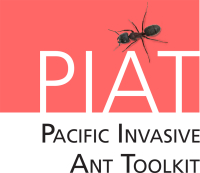Technical experts
Viv van Dyk of FBA Consulting. Viv and her team have led, consulted or worked on a wide range of invasive ant control projects in New Zealand and the Pacific, including yellow crazy ants and Argentine ants. FBA are actively involved in the annual survey of New Zealand ports for invasive ants.
Cas Vanderwoude, Michelle Montgomery and Heather Forester of the Hawaii Ant Lab. Cas is an invasive ant ecologist who specialises in little fire ant control in Hawaii and around the Pacific, but has also worked on control of yellow crazy ants. Michelle is a research specialist and Heather works on community outreach and awareness raising.
Ben Hoffmann of CSIRO Australia is an ant ecologist who specialises in invasive species ecology and eradication. He provides oversight to all ant eradication programs in Australia, and has personally led programs against African big-headed ant, tropical fire ant, Argentine ant, yellow crazy ant and the browsing ant.
Lori Lach of James Cook University is an ant ecologist who currently works on management of yellow crazy ants in Queensland, Australia. Lori has also reviewed a number of invasive ant management programs.
Phil Lester, Monica Gruber, Allan Burne and Meghan Cooling of Pacific Biosecurity, Victoria University of Wellington. Phil is a social insect ecologist (ants, bees and wasps), and his team work on research and management of yellow crazy ants, Argentine ants and invasive wasps in New Zealand and around the Pacific. Monica came up with the PIAT concept, and Allan, Meghan and Monica developed it.
Simon O'Connor was a Senior Adviser for the Invasive Ant Programme of MAF Biosecurity New Zealand, and worked as the coordinator for the initial Pacific Invasive Ant Prevention Plan. He now advises Chevron on biosecurity in Australia.
Dave Nendick of MPI (Biosecurity NZ) leads the Sea Container Hygiene System, which is targeted at ant and invertebrate biosecurity.
Christina Boser works for the Nature Conservancy and leads Argentine ant management projects on the California Channel Islands.
Bob Vander Meer, Sanford Porter and David Oi of USDA ARS in Gainesville, Florida are experts on the identification, management and invasion ecology of fire ants. Their group also works extensively on developing ground-breaking management tools for fire ants and many other invasive ant species.
Disna Gunawardana of MPI's Plant Health & Environment Laboratory is an entomologist (insect scientist) who is an expert at identification. She has led training in ant identification throughout the Pacific.
Eli Sarnat is an expert at identification. Eli has led training in ant identification throughout the Pacific and developed the Pacific Invasive Ant Key (PIAkey).
Herve Jourdan is based at the Institut Méditerranéen de Biodiversité et d'Ecologie Marine et Continentale (IMBE) in Noumea. Herve is an expert on the ecology and identification of ants in the Pacific, particularly in New Caledonia and French Polynesia
Robert Peck of Hawaii Cooperative Studies Unit, University of Hawaii at Hilo worked on the yellow crazy ant control programme on Johnston atoll.
Chris Green of the New Zealand Department of Conservation has led the successful Argentine ant eradication on Titritiri Matangi island.
Paul Krushelnycky at the University of Hawaii at Manoa is an expert on the invasive ants of Hawaii.
John Fasi of the Solomon Islands National University has researched little fire ants in the Solomon Islands and worked with local communities there.
Sheldon Plentovich is Pacific Islands Coastal Program Coordinator of the U.S. Fish and Wildlife Service. Sheldon has worked on yellow crazy ant management in Kaneohe Bay, Hawaii and Johnston atoll and has also worked on tropical fire ants.
Pete Green of LaTrobe University in Australia is an ecologist and is an expert on the invasion ecology of yellow crazy ants.
Shyama Pagad of the IUCN SSC Invasive Species Specialist Group manages the knowledge products of the Group, including the Global Invasive Species Database (GISD), the Global Register of Introduced and Invasive Species (GRIIS), the developing Island Biodiversity and Invasive Species Database (IBIS) and the Pathway Resources Database. All have significant information on invasive ants.
